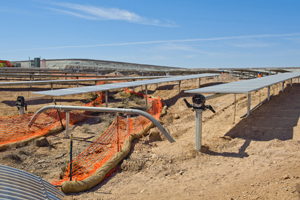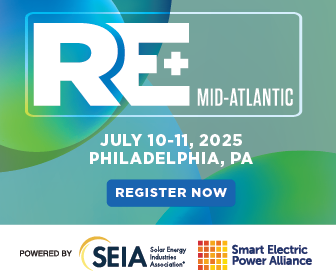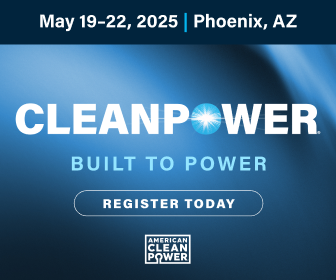The Future of Solar Power: Adding "environmental sustainability" to the clean, green energy mix
 Environmental sustainability is a sexy, trendy term that sparks interest as cocktail chatter. Although the definition of environmental sustainability is widely disputed, a common lexicon is that it promotes a state in which the demands placed on the environment can be met without reducing its capacity to allow people to live well—now and in the future.
Environmental sustainability is a sexy, trendy term that sparks interest as cocktail chatter. Although the definition of environmental sustainability is widely disputed, a common lexicon is that it promotes a state in which the demands placed on the environment can be met without reducing its capacity to allow people to live well—now and in the future.
How often do renewable resource developers have the chance to apply the sustainable doctrine in day-to-day activities? One could argue that in simply promoting the advancement of renewable resources, one is advancing the doctrines of environmental sustainability. However, what about the impact to the land and associated habitat disruption caused by the development of the renewable assets? From this slightly reversed perspective, the renewable site developer goes from advocate to intervenor.
It doesn’t have to be that way. The development of a renewable resource can incorporate environmental sustainability with little impact to land or habitats, while at the same time making life easier, and saving time and money. Sounds too good to be true, right?
Consider the following. Developers make considerable effort to screen sites in an effort to avoid potential encumbrances and minimize regulatory involvement. Still, even on privately held land, the gauntlet of permits and inconsistencies from one jurisdiction to the next often contribute to a high degree of risk, often compromising project viability. Some might see permits as a way to ensure environmental sustainability because most permits associated with land development are designed to protect natural resources.
An experienced developer knows that permits add both cost and schedule pressures: costs in terms of engaging experts to perform the requisite studies and applications, and schedules in terms of the duration to perform the studies and time required by the agency with jurisdiction to review the applications. Typically, the biggest threat to any renewable resource project is the permit and the possibility the reviewing agency will not give that green light (a growing concern considering that increasingly stringent regulations will make it even more difficult to advance development without regulatory involvement).
Why not take another step back in the development process and take the regulatory requirements out of the equation? In other words, strive to advance a development strategy that promotes harmony between land use and land benefit.
Case in point
To bring this point to light, consider a US solar developer who recently sought to develop a site that included a number of jurisdictional washes. The typical approach would have been to submit a pre-construction notification (PCN) and apply for a nationwide or individual permit through the US Army Corps of Engineers (USACE), fill the washes, and construct the site to an appropriate grading profile. Depending on the required permit, an additional year (or more) could be added to the project schedule, which would have put the project at risk of missing the customer’s commercial operation date.
Due to the need for a Section 404 (B) (1) Alternatives Analysis (under an individual permit scenario), there was a high likelihood the project would not have been approved at this site. Even if approved, the study alone would have exceeded $150,000, not including mitigation measures both on and offsite.
Instead, the developer stepped back and asked its engineering design team to come up with a way to avoid the jurisdictional washes. As a result, the engineers opted to vary the height of the solar array foundations, so there was no impact to the jurisdictional washes and the topography of the site was left largely unchanged. A foundation is typically four feet in height. The foundations in this development ranged from two feet to eight feet. In addition, engineers had to span several washes, which required that the typical 10-foot on-center span between foundations be exceeded.
The project included the addition of buffer areas and native plantings, which in combination with protecting the integrity of the ephemeral waterways, minimized the impact to the local habitat. Although the project could have been designed and permitted conventionally using techniques of mass grading, installation of storm water BMPs, and a much greater disturbed footprint, the result was a project that worked within the existing regulatory framework—with a minimally disturbed footprint. There were fewer permits to obtain and less impact to sensitive environmental features on the property. The site development strategy took the regulatory effort out of the equation, resulting in a project with a lower site development cost and fewer permitting obstacles.
Environmental harmony & NWPs
Through creative solutions and design harmonization, it’s often possible to avoid unnecessary environmental impacts and eliminate the need for permitting. Engineering design focused on environmental harmony allows developers to better control development schedules instead of waiting at the mercy of a regulator. This also leads to cost control and less or no concerns about mitigation, conveyances, and land banks.
In these times of increasing regulations, developers would be well advised to seek more sustainable solar solutions. With new regulations on the horizon, what would have been a profitable venture in 2011, may not be in 2012. Keep in mind, those project commenced or put under contract after March 2012 will fall under the new USACE nationwide permits (NWPs). For land-based solar projects, the new NWP is more restrictive than permitting on past solar projects, requiring a PCN in all instances where the thresholds are exceeded (one-tenth acre and/or more than 300-linear feet of disturbance in non-tidal areas).
Take the regulatory framework out of the equation. Look to engineering professionals to avoid disturbing protected species and jurisdictional waters, and find a prescriptive solution to affordable, timely, and sustainable solar development.
Blair Loftis is the global director of renewable energy at Kleinfelder.
Kleinfelder
www.kleinfelder.com
Author: Blair Loftis
Volume: March/April 2012











.jpg?r=9750)
